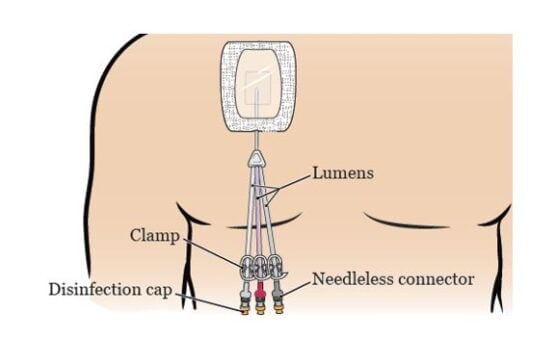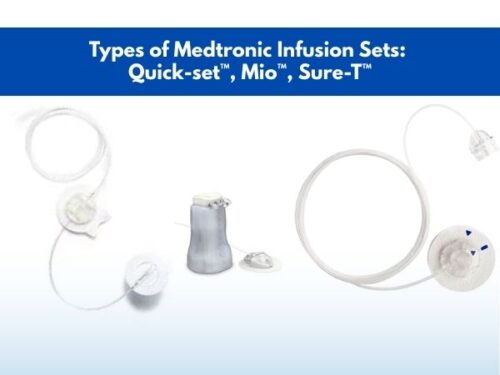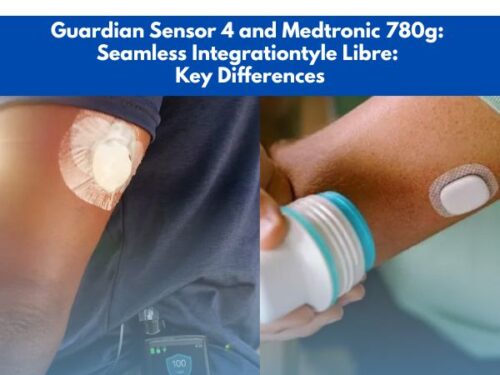What are tunneled catheters? What are their types?

What are tunneled catheters? What are their types?
In patients who often require a dose of intravenous medication or total parenteral nutrition (TPN), the route of drug administration must be convenient enough not to disrupt their lifestyle. One of these distinct and non-conventional ways of drug or nutrition administration is delivery via the jugular vein with the help of tunneled catheters.
What Are Tunneled Catheters?
A tunneled catheter is a hollow, flexible tube that is placed under the skin via the neck region and is extended into the jugular vein in order to reach the cavoatrial junction just above the heart. It is also called tunneled dialysis catheter (TDC). Designed for long-term use, this type of catheter is often used for administering chemotherapy, dialysis, or total parenteral nutrition (TPN). The catheter is tunneled through the subcutaneous tissue, exiting the skin at a different site from where it enters the vein, reducing the risk of infection and providing stability.
Key Features:
– Long-Term Use: Ideal for treatments requiring extended vascular access.
– Reduced Infection Risk: The tunneling process separates the catheter entry and exit points, minimizing infection risks.
– Flexible and Secure: The catheter’s design ensures it remains securely in place while allowing flexibility for patient movement.
Common Uses:
– Chemotherapy: For patients undergoing long-term cancer treatment.
– Dialysis: For individuals requiring regular dialysis sessions.
– Total Parenteral Nutrition (TPN): For those who need long-term intravenous nutrition.
What are the Types of tunneled catheters
The tunneled catheters are of the following types:
1- Hickman line or Hickman tunneled central venous catheter (CVC)
2- Broviac or multi-lumen Hickman long-term dialysis catheter (particularly useful in pediatric patients)
3- Groshong tunneled central venous catheter (with tubing made up of silicone)

Three types of tunneled catheters
Placement of a tunneled catheter
A tunneled catheter can be placed into the body by the following steps:
• The patient is asked to lie down flat on the procedure table.
• Relaxants can be given to the patient to reduce anxiety.
• Blood thinning medications can be required to avoid the formation of blood clots at the tip of the tunneled catheter. Moreover, in the case of a diabetic patient, a readjustment of the insulin dose may be required before the procedure. Similar is the case with the patients on diuretics.
• Clean the patient’s skin near the neck and chest area with special soap in order to sterilize it.
• To ensure the sterility of the procedure, a blue drape can be placed across the patient’s chest.
• Once everything is in place, the physician will scan the chest area with an ultrasound device to find out the exact location of the jugular vein.
• At this point, the patient must be treated with some numbing solution to alleviate the sense of pain.
• To access the jugular vein, a small incision is made near the collarbone. An x-ray can be done to further confirm the location.
• An incision is then made a few centimeters above the nipples and the tunneled catheter will be administered via it.
• During the administration procedure, the patient should be asked to hold his or her breath for a few seconds.
• Once done, another x-ray scan can verify the position of the tunneled catheter in the body.
• Once everything is done properly, the neck and chest area must be cleaned and stitched.
• Tape or glue can be used to attach the catheter to the skin to reduce its chances of falling off.
• In the end, a sterile gauze along with clear tape should be placed on the catheter.
• In case of pain or discomfort reported by the patient, acetaminophen or ibuprofen can be given.

A tunneled catheter set into a patient’s central vein
Taking care of a tunneled catheter
The following measures must be adopted to take care of the site of administration of the tunneled catheters:
• A place where a tunneled catheter should be is applied should be kept clean and dry.
• The area must be covered with a plastic sheet while taking a bath.
• Sharp objects must be kept away from the site.
• Contact your physician or nurse every 4 weeks in order to flush the catheter.
Applications of tunneled catheters
The tunneled central venous catheters find vast applications some of which are as follows:
• To draw blood samples
• To administer fluids
• To perform hemodialysis
• To administer TPN i.e. total parenteral nutrition
• To conduct plasmapheresis i.e. the removal of certain elements from the blood
• To administer chemotherapeutic drugs and antibiotics along with several other medications
• To transfuse blood
• To provide nutrition via the intravenous (IV) route
When to avoid the use of tunneled catheters?
The use of tunneled catheters should be avoided in the following cases:
• In case of an infection in the bloodstream
• In case of a skin infection near the area through which a tunneled catheter is to be injected into the body
• In case of an allergic reaction to the material of the catheter
• In case of a bleeding disorder
• In the case of thrombosis i.e. a localized blood clot in the vein
Advantages of a tunneled catheter
The tunneled catheters provide the following advantages:
• A tunneled catheter can be used for longer periods of time ranging from several weeks to several years without causing any trouble.
• In cases when a medication can only be given via a tunneled catheter, they are the best and only choice for drug delivery.
• Just like their easy administration, it is uncomplicated to remove them as well.
Side effects of tunneled catheters
The following side effects can occur with the use of tunneled catheters:
• The tunneled catheters can infuse an infection into the body. To reduce this risk, they are prepared sterile.
• Bleeding can occur while a tunneled catheter is being injected. Normally, it should stop within a few minutes. However, if it does not, the catheter should be pulled out and the patient should be treated according to his or her condition.
• Sometimes, a blood clot can be formed at the tip of the tunneled catheter thus rendering it useless. This can also result if the catheter is misplaced. To avoid the issue, it is recommended to tape the catheter in order to secure it in its place. A small amount of a blood thinner e.g. Heparin can also be employed to avoid the possibility of clot formation.
Conclusion
The tunneled catheters are the handiest medical instruments for the delivery of drugs via unconventional routes. These provide an advantage to the physician as well as the patient owing to their easy administration and long-lasting usage. Administration of chemotherapeutic drugs, supply of nutrition or TPN, and blood transfusion are some of the advantages provided by tunneled catheters thus making them a preferred choice of physicians.



















